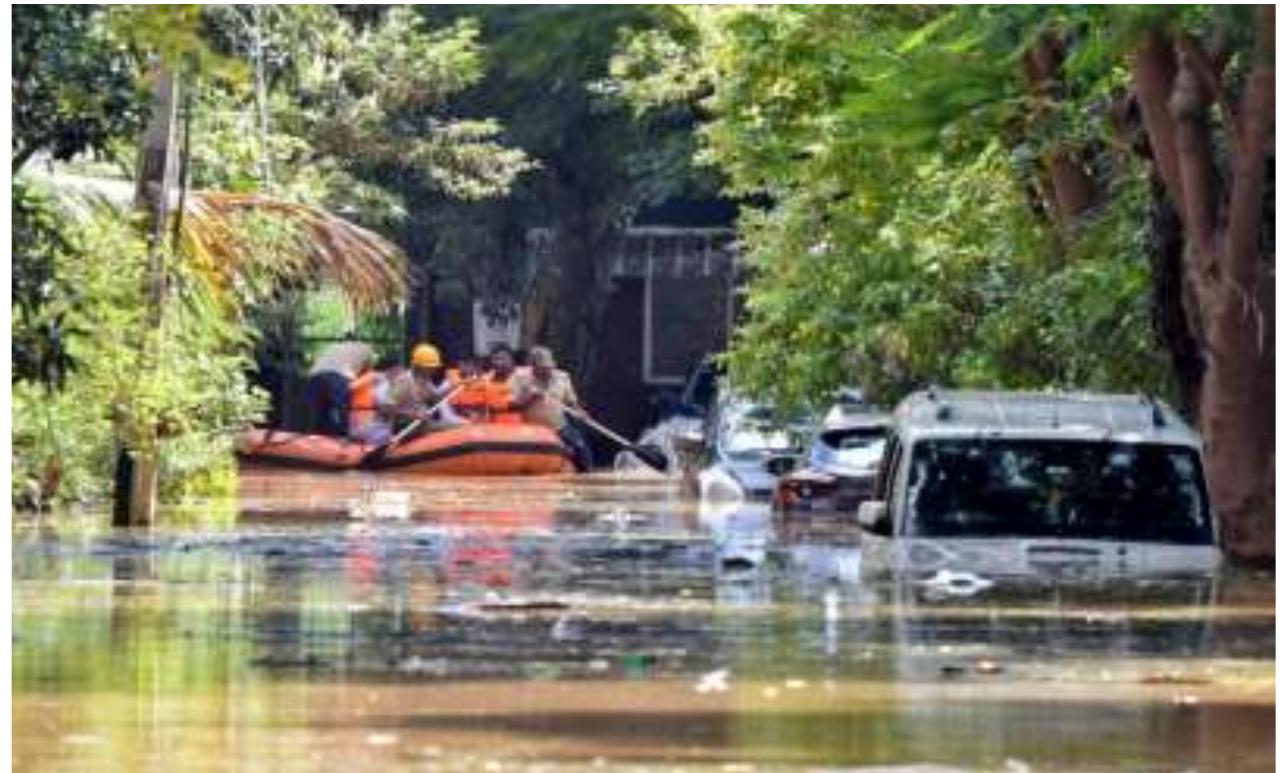Bengaluru techie’s 25 kms commute nightmare: ‘Everyone’s angry, sweaty, and silently screaming’ – Hindustan Times

Report on Urban Commuting Challenges in Bengaluru and Implications for Sustainable Development Goals
Executive Summary
A widely circulated social media post from a software engineer in Bengaluru has brought critical attention to the severe challenges of the city’s public transportation system. The account details a 25-kilometer commute, exposing systemic failures that directly conflict with the United Nations’ Sustainable Development Goals (SDGs). This report analyzes the commuter’s experience, framing it within the context of urban infrastructure, public health, and environmental sustainability.
Case Study: A Daily Commute on Bengaluru’s Outer Ring Road
The subject, a software professional, documented his daily journey following a return-to-office mandate. His attempt to utilize public transport as an environmentally responsible choice resulted in an experience described as “certified insanity.” Key issues reported include:
- Infrastructure and Safety Deficiencies: The commuter was dropped off on a flyover with no designated bus stop or safe pedestrian crossing, forcing him to navigate high-speed traffic.
- Operational Inconsistencies: Conflicting actions and instructions from different transport staff members highlighted a lack of standardized, safe operating procedures.
- Overcrowding and Poor Service Quality: Buses were reported as severely packed, and the conduct of staff was described as unhelpful and stressed.
- Exacerbating Factors: Ongoing metro construction along the Outer Ring Road has intensified traffic congestion, compounding the difficulties for public transport users.
Analysis of Sustainable Development Goal (SDG) Implications
The challenges documented in the commuter’s report have significant negative implications for several key SDGs, indicating a disconnect between the city’s growth and its sustainability targets.
SDG 11: Sustainable Cities and Communities
This goal is central to the issue. The commuter’s experience directly undermines Target 11.2, which aims to “provide access to safe, affordable, accessible and sustainable transport systems for all.”
- Safety: The lack of designated, safe bus stops and pedestrian infrastructure creates a hazardous environment for commuters.
- Accessibility: While physically present, the system’s unreliability, overcrowding, and operational chaos render it inaccessible as a practical, daily solution for many.
- Sustainability: A public transport system that fails its users cannot be considered sustainable, as it discourages use and pushes citizens toward private, less eco-friendly transportation methods.
SDG 3: Good Health and Well-being
The daily commute, as described, poses direct risks to the physical and mental health of citizens.
- Mental Health: The report’s description of commuters as “angry, sweaty, and silently screaming” points to high levels of stress, anxiety, and frustration, which are detrimental to mental well-being.
- Physical Safety: The necessity of dodging traffic due to improper drop-off points presents a clear and immediate risk of injury or death.
- Public Health: Extreme traffic congestion, worsened by inadequate public transport, contributes to higher levels of air and noise pollution, impacting the respiratory and cardiovascular health of the entire urban population.
SDG 9: Industry, Innovation, and Infrastructure
The account highlights a failure to build resilient, reliable, and sustainable infrastructure capable of supporting a major economic hub like Bengaluru.
- Infrastructure Deficit: The existing road and public transport infrastructure is insufficient to handle the city’s population density and economic activity.
- Delayed Innovation: While the metro project represents a long-term solution, its protracted construction phase currently worsens the very problem it aims to solve, indicating poor project planning and management.
SDG 8: Decent Work and Economic Growth
The quality of a city’s commute is directly linked to the productivity and well-being of its workforce.
- Reduced Productivity: Employees arriving at work after a stressful and exhausting commute are likely to be less productive and engaged.
- Poor Working Conditions: The description of transport staff as being “five seconds away from quitting” suggests that they too are operating under stressful conditions, which impacts service quality and reflects issues within the “decent work” paradigm.
SDG 13: Climate Action
The failure of the public transport system actively works against climate goals. The commuter initially chose the bus as an “eco-friendly choice.” However, such negative experiences create a strong disincentive for using public transport, leading to increased reliance on private cars and motorcycles, which in turn elevates the city’s carbon footprint.
1. Which SDGs are addressed or connected to the issues highlighted in the article?
SDG 3: Good Health and Well-being
The article highlights the negative impact of the commute on the mental and physical well-being of the commuter. The description of the experience as a “test of endurance” where “Everyone’s angry, sweaty, and silently screaming” points to significant mental stress. Furthermore, the safety risks, such as being “dropped on a flyover” and having to “dodge high-speed traffic,” directly threaten physical health and safety.
SDG 9: Industry, Innovation, and Infrastructure
This goal is central to the article, which critiques the “state of Bengaluru’s public transport infrastructure.” The issues of “packed buses,” “unsafe drop-off points,” and the “never-ending metro construction on Outer Ring Road” all point to a failure in providing quality, reliable, and resilient infrastructure necessary for a functioning city and its economy.
SDG 11: Sustainable Cities and Communities
The article is a direct commentary on the challenges of urban life in Bengaluru. It addresses the need for safe, affordable, and sustainable transport systems. The commuter’s experience illustrates a public transport system that is unsafe, inefficient, and inaccessible, as seen when he is dropped “in the middle of nowhere” without a designated bus stop or safe crossing. The overall “chaotic picture” of the city’s roads points to issues in sustainable urban planning and management.
2. What specific targets under those SDGs can be identified based on the article’s content?
-
SDG 3: Good Health and Well-being
- Target 3.6: By 2030, halve the number of global deaths and injuries from road traffic accidents. This is relevant because the techie was forced to “dodge high-speed traffic” after being dropped off at an unsafe location on a flyover, highlighting a direct risk of a road traffic accident.
-
SDG 9: Industry, Innovation, and Infrastructure
- Target 9.1: Develop quality, reliable, sustainable and resilient infrastructure… with a focus on affordable and equitable access for all. The article directly challenges the quality and reliability of Bengaluru’s transport infrastructure, citing “packed buses,” “unsafe drop-off points,” and the disruptive “never-ending metro construction.” The commuter’s ordeal shows a lack of equitable access to safe infrastructure.
-
SDG 11: Sustainable Cities and Communities
- Target 11.2: By 2030, provide access to safe, affordable, accessible and sustainable transport systems for all, improving road safety, notably by expanding public transport. The entire article is an account of a public transport system that fails to be safe (dropped on a flyover), accessible (no designated stops), or sustainable (leading to extreme stress and chaos). The commuter’s attempt to use public transport as an “eco-friendly choice” was met with “certified insanity.”
3. Are there any indicators mentioned or implied in the article that can be used to measure progress towards the identified targets?
Yes, several indicators are mentioned or implied:
- Commute distance and time: The article explicitly mentions a “25 kms commute” which is described as a “nightmare” and a “test of endurance.” The time taken for this commute serves as an implicit indicator of transport efficiency and traffic congestion.
- Availability of safe pedestrian infrastructure: The lack of a “footpath or crossing” when the commuter was dropped on a flyover is a direct indicator of unsafe infrastructure for pedestrians and public transport users.
- Accessibility of public transport services: The incident where the commuter was told, “This is not a stop! Go to the bus stop!” after being dropped far from one indicates a lack of convenient and logical access to public transport stops. The number and placement of designated and safe bus stops is a measurable indicator.
- Passenger experience and satisfaction: The commuter’s description of the experience (“angry, sweaty, and silently screaming,” “fraying tempers”) and the behavior of the staff (“conductor treats you like you owe him rent”) are qualitative indicators of passenger satisfaction with the public transport service.
- Road safety incidents: The need to “dodge high-speed traffic” implies a high risk of accidents. The number of pedestrian-related incidents or near-misses in such locations would be a direct indicator for road safety.
- Traffic Congestion Levels: The article refers to the “notoriously congested Outer Ring Road” and “traffic woes,” which can be measured through traffic flow data and average vehicle speeds.
4. Table of SDGs, Targets, and Indicators
| SDGs | Targets | Indicators (Identified from the article) |
|---|---|---|
| SDG 3: Good Health and Well-being | 3.6: Halve global deaths and injuries from road traffic accidents. |
|
| SDG 9: Industry, Innovation, and Infrastructure | 9.1: Develop quality, reliable, sustainable and resilient infrastructure. |
|
| SDG 11: Sustainable Cities and Communities | 11.2: Provide access to safe, affordable, accessible, and sustainable transport systems for all. |
|
Source: hindustantimes.com

What is Your Reaction?
 Like
0
Like
0
 Dislike
0
Dislike
0
 Love
0
Love
0
 Funny
0
Funny
0
 Angry
0
Angry
0
 Sad
0
Sad
0
 Wow
0
Wow
0








































































